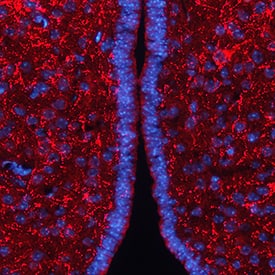Mouse AgRP/ART Antibody
R&D Systems, part of Bio-Techne | Catalog # AF634

Key Product Details
Species Reactivity
Validated:
Cited:
Applications
Validated:
Cited:
Label
Antibody Source
Product Specifications
Immunogen
Val25-Thr131
Accession # P56473
Specificity
Clonality
Host
Isotype
Scientific Data Images for Mouse AgRP/ART Antibody
AgRP/ART in Mouse Brain.
AgRP/ART was detected in perfusion fixed frozen sections of mouse brain (hypothalamus) using Goat Anti-Mouse AgRP/ART Antigen Affinity-purified Polyclonal Antibody (Catalog # AF634) at 1.7 µg/mL overnight at 4 °C. Tissue was stained using the NorthernLights™ 557-conjugated Anti-Goat IgG Secondary Antibody (red; NL001) and counterstained with DAPI (blue). View our protocol for Fluorescent IHC Staining of Frozen Tissue Sections.Applications for Mouse AgRP/ART Antibody
Immunohistochemistry
Sample: Perfusion fixed frozen sections of mouse brain (hypothalamus)
Formulation, Preparation, and Storage
Purification
Reconstitution
Formulation
Shipping
Stability & Storage
- 12 months from date of receipt, -20 to -70 °C as supplied.
- 1 month, 2 to 8 °C under sterile conditions after reconstitution.
- 6 months, -20 to -70 °C under sterile conditions after reconstitution.
Background: AgRP/ART
Agouti-Related Protein (AgRP), the protein product of the Agouti-Related Transcript (ART), is a neuroprotein that regulates energy metabolism and the development of obesity by antagonizing alpha-melanocyte stimulating hormone ( alpha-MSH) action on MC-3 and MC-4 receptors (1-4). AgRP is predominantly expressed in the hypothalamus and adrenal medulla (5). Mature mouse AgRP is a 111 amino acid (aa) polypeptide; its C-terminal portion contains ten conserved cysteines that form five disulfide bonds (5, 6). Within the C-terminal region, mouse AgRP shares 80% and 90% aa sequence identity with human and rat AgRP, respectively. It also shares 44% aa sequence identity with Agouti. As with Agouti, the C-terminal cysteine-rich region is sufficient for biological activity (7). AgRP, however, is 100 times more potent than Agouti in antagonizing MC-3 and MC-4 receptors (8). AgRP also induces the beta-arrestin dependent endocytosis of MC-3 and MC-4 (9). Hypothalamic expression of AgRP is upregulated in obesity and diabetes (5, 10), and chronic AgRP administration increases food intake and weight gain in rats (11). Genetically-linked polymorphisms of AgRP in humans are associated with susceptibility to anorexia nervosa (12, 13). In addition, AgRP inhibits the ACTH-induced synthesis of steroid hormones via a mechanism that does not involve melanocortin receptors (14).
References
- Martin, N.M. et al. (2006) Peptides 27:333.
- Fan, W. et al. (1997) Nature 385:165.
- Ollmann, M.M. et al. (1997) Science 278:135.
- Arora, S. and Anubhuti (2006) Neuropeptides 40:375.
- Shutter, J.R. et al. (1997) Genes Dev. 11:593.
- Kiefer, L.L. et al. (1998) Biochemistry 37:991.
- Jackson, P.J. et al. (2002) Biochemistry 41:7565.
- Fong, T.M. et al. (1997) Biochem. Biophys. Res. Commun. 237:629.
- Breit, A. et al. (2006) J. Biol. Chem. 281:37447.
- Katsuki, A. et al. (2001) J. Clin. Endocrinol. Metab. 86:1921.
- Small, C.K. et al. (2001) Diabetes 50:248.
- Vink, T. et al. (2001) Mol. Psychiatry 6:325.
- Dardennes, R.M. et al. (2007) Psychoneuroendocrinology 32:106.
- Doghman, M. et al. (2007) Mol. Cell. Endocrinol. 265-266:108.
Long Name
Alternate Names
Gene Symbol
UniProt
Additional AgRP/ART Products
Product Documents for Mouse AgRP/ART Antibody
Product Specific Notices for Mouse AgRP/ART Antibody
For research use only
